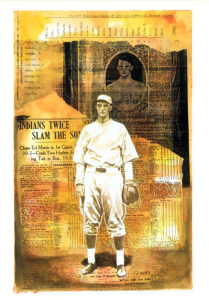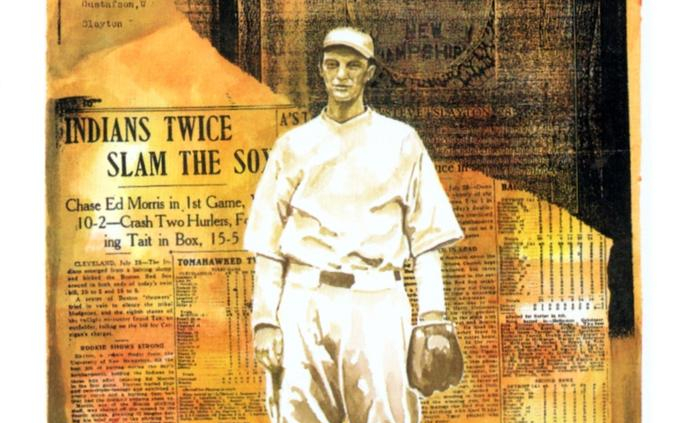Steve Slayton
 A right-handed relief pitcher, Steve Slayton had appeared in only three games for the 1928 Boston Red Sox when an unfortunate misunderstanding with his manager resulted in his demotion to the minor leagues. When a back problem prevented him from returning to the majors, he turned to teaching and became a hugely success-ful high-school baseball coach. Those who knew the taciturn Slayton remember him as a “quiet winner.”
A right-handed relief pitcher, Steve Slayton had appeared in only three games for the 1928 Boston Red Sox when an unfortunate misunderstanding with his manager resulted in his demotion to the minor leagues. When a back problem prevented him from returning to the majors, he turned to teaching and became a hugely success-ful high-school baseball coach. Those who knew the taciturn Slayton remember him as a “quiet winner.”
Foster Herbert Slayton was born on a farm in Barre on April 26, 1902. As a youngster he was constantly expectorating, so his brother dubbed him “Steve” because it sounded like the noise he made when he spit. After graduating from Barre’s Spaulding High School in 1920, Steve enrolled at Norwich University but was forced to withdraw in the spring of his freshman year when his father died unexpectedly.
Slayton received his first taste of professional baseball with Waynesboro, Pennsylvania, of the Class D Blue Ridge League during the summer of 1924, playing under the alias of Steven Foster to protect his amateur status. That fall he reentered college, this time at the University of New Hampshire, where he joined the Kappa Sigma fraternity and was captain of the basketball team.
Slayton was also captain of the freshman baseball team in 1925, then earned three varsity letters in baseball under coach Hank Swasey. To this day he holds UNH career records for com-plete games (16) and innings pitched (206). His greatest perfor-mance came in 1928, the year he led the Wildcats to an 11-8 record.
That spring Notre Dame came to Durham with one of the top college teams in the country, but the 26-year-old senior upset the Irish by pitching a three-hit shutout and the national press picked up the story. Following his graduation in June, Slayton signed with the Boston Red Sox and went directly from campus to the major leagues.
Steve Slayton’s manager in Boston was Bill “Rough” Carrigan, the same hard and aggressive man who had managed Larry Gardner and Ray Collins back when the Red Sox were champions. After win-ning the World Series in 1916, Carrigan quit baseball at the peak of his success to become a banker in his hometown of Lewiston, Maine. He was persuaded to return in 1927, but in his absence the Red Sox had fallen on hard times. Boston was in the midst of finishing last in nine out of eleven seasons. Carrigan managed the team for three years, 1927 through 1929, and finished last three straight times.
Joining the Red Sox in the middle of Carrigan’s tenure, Steve Slayton made his big-league debut at Fenway Park on July 21, 1928. Before an unusually large crowd of 17,000 on hand for “Ira Flagstead Day,” Slayton pitched a scoreless ninth inning in a 5-1 loss to the Cleveland Indians. His next appearance came at Cleveland on July 25, and although the Red Sox lost both games of a doubleheader, 10-2 and 15-5, the Boston Post sung his praises: “Slayton, a rookie flinger from the University of New Hampshire, did the best job of hurling during the day’s bombardment, holding the Indians to three hits after relieving Ed Morris in the first game. Slayton hurled four and two-thirds innings and exhibited a pretty curve and a burning fast ball that had the Indians popping them up.”
Slayton’s son, David, remembers his father mentioning that one of the hits he surrendered was a double to Hall-of-Famer Charlie Gehringer of the Tigers. Sure enough, records confirm that at Detroit on July 28, in Slayton’s third and final appear-ance in the majors, Gehringer doubled off him to knock in Marty McManus.
To that point Steve had pitched well enough to stay with the Red Sox, giving up only six hits in seven innings for a 3.86 ERA. Why, then, was the game at Detroit his last?
David Slayton remembers his father talking about a bizarre mix-up in that game: Carrigan had instructed the Red Sox to employ a shift against certain hitters, and Slayton was pitching when Rough visited the mound to give him some advice. Before the manager returned to the dugout, Slayton asked him, “No shift?” Carrigan, who was hard of hearing, misheard the question and thought instead that his rookie pitcher had made a wise comment. According to the story, to teach Slayton a lesson Carrigan sent him to Haverhill of the Class B New England League, then after the season the Red Sox released him.
As strange as that story sounds, newspaper accounts of the inning before Slayton was roughed up by Gehringer suggest that it might well be accurate. He entered with the bases loaded and only one out, certainly a time when a manager would want to have a word with his rookie pitcher. In this case the rookie worked out of the jam relatively unscathed, yielding a sacrifice fly before striking out Jack Warner to retire the side, but his arm was unable to rectify the damage his tongue had already caused.
By 1928 Branch Rickey, general manager of the St. Louis Cardinals, had already developed the first modern farm system, controlling 203 players on eight Cardinals-owned minor-league teams. Figuring his odds of hooking on with a team were better in such a huge organization, Steve Slayton attended a Cardinals tryout camp in 1929 and was one of six players signed by Rickey from among a field of 150.
That summer he developed back trouble and, in his own words, “lost my stuff in midseason.” Slayton bounced from teams in Allentown to Waynesboro (where he had started five years earlier) to Portland, Maine. His back pain was diagnosed as a problem with infected teeth, but it continued even after he had every one of his teeth pulled.
Slayton attempted a comeback with Portland in 1930 but failed to finish out the season, retiring from professional base-ball at the age of 28. Later that year he married Grace Lockwood of Dover, New Hampshire, who was still a student at UNH at the time. Six years later they had David, their only child.
For years David held on to his father’s baseball memorabil-ia, but he threw it away only one year before he was interviewed for this article. “Those scrapbooks hung around for 70 years and I
figured that was long enough,” David said. “I didn’t know anyone at this point would be interested in my father’s baseball life.”
Somewhere there still exists a Fox Movietone News photograph of Steve Slayton posing with Babe Ruth and Lou Gehrig during a long-ago spring training in Florida. While on vacation a few years ago a relative saw it in an exhibit at Disney World, and David remembers his father mentioning it: “He was talking to Gehrig when Ruth sat down next to him. Photographers wanted to take [the two Yankees’] picture so he got up to leave, but Gehrig said, ‘Sit down. You’re alright just where you are.’”
After retiring from baseball Slayton taught and coached for twelve years at Traip Academy in Kittery, Maine, in time becoming the highest-paid baseball coach in the state. During World War II he returned to Vermont and trained Air Force cadets on the campus of the University of Vermont, where he became acquainted with Larry Gardner. Although he was in his 40s, Slayton ran seven-mile stints with the cadets three times per day. Throughout this period he earned extra money during summers by pitching in semi-professional leagues.
After the war Slayton stayed in his native state and took a teaching and coaching post at St. Johnsbury Academy. In 1948 he joined the faculty of the Tilton School in New Hampshire, where he coached football and baseball. Then in 1957 Slayton returned to Barre and coached the Spaulding High School baseball team. Over nine seasons he compiled a remarkable 115-22 record at Spaulding, leading the team to two undefeated seasons and four Vermont state titles before retiring in 1966.
Still bothered by the back problem that had caused him to retire from baseball 50 years earlier, Steve moved to Raymond, New Hampshire, in 1980 to live with his son. After a brief illness, he died in Manchester’s Elliott Hospital on December 20, 1984. Slayton was interred in Barre’s Hope Cemetery, which is famous for its intricately carved granite grave markers. His final resting place is not far from that of Walt Lanfranconi, another Vermont big leaguer who was born in Barre.
On October 31, 1986, Steve Slayton was inducted posthumously into the University of New Hampshire’s 100 Club Hall of Fame. His plaque hangs in the UNH fieldhouse where a namesake grandson worked during his senior year at UNH in 1997.
Sources
A version of this biography originally appeared in Green Mountain Boys of Summer: Vermonters in the Major Leagues 1882-1993, edited by Tom Simon (New England Press, 2000).
In researching this article, the author made use of the subject’s file at the National Baseball Hall of Fame Library, the Tom Shea Collection, the archives at the University of Vermont, and several local newspapers.
Full Name
Foster Herbert Slayton
Born
April 26, 1902 at Barre, VT (USA)
Died
December 20, 1984 at Manchester, NH (USA)
If you can help us improve this player’s biography, contact us.


